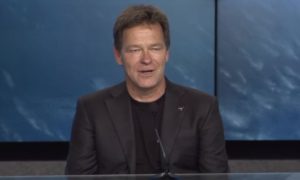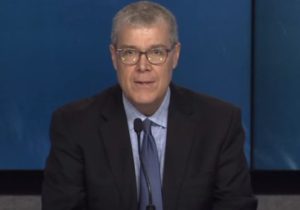A SpaceX official expressed optimism today that the company’s commercial crew system will be ready to take astronauts into space by this time next year. NASA’s deputy International Space Station (ISS) program manager was a bit more cautious, estimating “in the FY2019 period.”

SpaceX’s Hans Koenigsmann, Vice President of Build and Flight Reliability, and NASA’s Dan Hartman, made the comments during a post-launch press conference following the successful launch of SpaceX CRS-12 (SpX-12).
SpaceX’s Falcon 9 rocket lifted off from Kennedy Space Center (KSC) on time at 12:31 pm ET today sending a Dragon spacecraft filled with 6,400 pounds of supplies, equipment and scientific experiments to the ISS.
Dragon is scheduled to arrive at the ISS on Wednesday morning and be grappled by ISS astronauts using the robotic Canadarm2 at 7:00 am ET. Canadarm2 later will be used to berth the spacecraft to an ISS port where it will remain attached for about 35 days before returning to Earth full of equipment and the results of scientific experiments.
The Falcon 9 first stage returned to land at Cape Canaveral Air Force Station, which is adjacent to KSC. SpaceX is trying to demonstrate the economic benefits of reusing rockets and spacecraft. This marks the 14th successful landing of a Falcon 9 first stage – six on land and eight on autonomous drone ships at sea.

SpaceX has launched “pre-flown” or reused stages for commercial customers already. Asked when NASA would be ready to use one, Hartman said the agency is close to making that decision, but it will not be the next SpaceX cargo launch.
The cargo launch today is part of NASA’s commercial cargo program where it partnered with SpaceX and Orbital ATK to build new rockets and spacecraft to take cargo to the ISS.
NASA also has partnered with SpaceX and Boeing to build systems to take crews to and from ISS. NASA must rely on Russia to do that now because Presidents Bush and Obama decided to terminate the space shuttle system before a U.S. replacement was ready. The United States has not been able to launch people into space since the final shuttle launch in 2011.
The date for when the SpaceX and Boeing commercial crew systems were to be operational has slipped from 2015 to 2018 for a variety of reasons and apart from the companies themselves, there is substantial skepticism that they will be ready by 2018.
Today, however, Koenigsmann conveyed confidence that SpaceX, at least, will be flying its system by this time next year. Everything is “coming together at a great pace…. Pretty sure a year from now looks about right.”
The “Dragon 1” capsule launched today cannot carry people. A crew-capable version of Dragon is under development for these missions, variously called Dragon 2, Dragon v2, or Crew Dragon. It has many differences from the model used today, including the addition of life support systems, launch abort systems, and docking rather than berthing mechanisms.
Hartman said NASA is “eager” to have Dragon 2 taking crews to ISS, but offered a broader range of dates — “in the FY2019 period,” which runs from October 1, 2018 – September 30, 2019. He added that NASA may want to use Dragon 2 in a cargo mode first to “get some more flights under its belt” before committing to crews. NASA and SpaceX are working together to determine when the “conversion time” from Dragon 1 to Dragon 2 should occur.
SpaceX does not have its own astronauts. NASA selected four of its astronauts to train for the Dragon 2 missions: Robert Behnken, Eric Boe, Douglas Hurley and Sunita Williams. Only two will fly on the early Dragon 2 flights, although the spacecraft can accommodate four. Hartman said the agency will decide “in a month or two” who will fly on the first mission.
Quelle: SPACEPOLICYONLINE.COM
